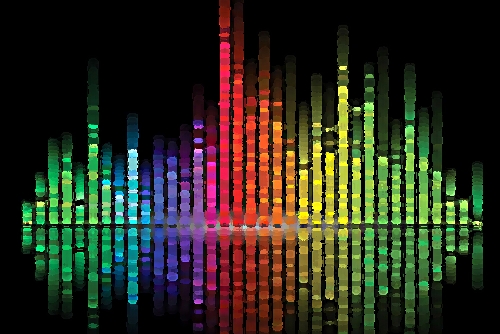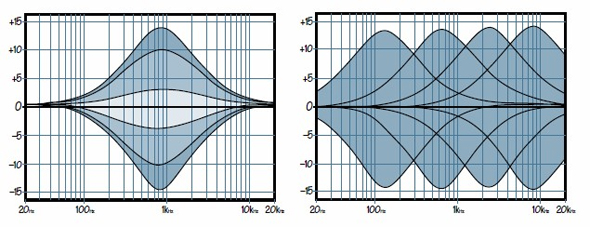
Whether you cut or boost frequencies your adjustments should always support the sound source.
Most mixing boards will have one or two controls that are sweep EQs. That is, they can be tuned to add or subtract any desired frequency within their sweep range.
Now the thing that makes these controls a little tricky is that the two knobs interact. That is, you have to use them both or it will be useless. Don’t understand how they work, then look at the picture below/right.
Note that in addition to the top and bottom knobs marked LOW 80 Hz and HI 12K, there’s also two knobs in the middle with mysterious marking.
The upper middle control is marked with a U in the center and -15 and +15 markings at the counterclockwise and clockwise positions.
The lower middle knob is marked as 100, 200, 800, 2K, and 8K. Those are actually frequencies in Hz (Hertz) or cycles per second. If you refer back to the frequency chart on page 1, you’ll note that the middle A on a piano is 440 Hz, and each octave up doubles the frequency, while each octave below halves the frequency.
So how does it all work? Glad you asked. The HI and LOW controls do just what they say. The 12 o’clock top position marked as U refers to unity gain. That is, at unity gain there is no effect on those frequencies, so whatever sound source you put in comes out exactly the same. British mixing boards usually are labeled as 0 (zero) at the top, which is exactly the same thing. Each one of the notches in the circle is another 3 dB (decibels) of BOOST or CUT.
So if you twist the HI control clockwise to first notch on the right, which is +3 dB, you’re boosting frequencies around 12 kHz by 3 dB, essentially doubling the high-frequency energy. If you twist it counter-clockwise to the first notch, which is -3 dB just left of the U at the top, you’re cutting the high-frequency energy by 3 dB, or half the power. Each notch will add or subtract 3, 6, 9, 12, or 15 decibels.
You may remember that this equates to 2, 4, 8, 16 and 32 times the original power when going to the right-plus side, or 1/2, 1/4, 1/8, 1/16 and 1/32 of the power when going to the left-minus side. If you grab the LOW control and turn it to the second notch on the right, that’s 6 dB of boost around 80 Hz and below, which is 4 times the bass power that was sent into the strip from the original sound source. Going to the second notch on the left is cutting the power to 1/4 of the original level. Same goes for the HI control but at the 12 kHz and above frequencies. Seems simple enough, doesn’t it.
As you rotate the HI and LOW controls from center to the far left and right, listen to what the instrument sounds like. Too many highs will make it shrill, while too few highs will make it dull sounding. Too much bass boost will make it boomy, while too little bass will make it sound too thin.
Here’s a brief list of different frequencies and how they affect our perception of a particular sound.
—Sheen: 10 kHz to 14 kHz
—Sibilance: 7 kHz to 8 kHz
—Presence: 3 kHz to 5 kHz
—Main vocals: 800 to 2,000 Hz
—Nasal honk: 400 to 600 Hz
—Tubbiness: 200 to 400 Hz
—Boom: 80 to 200 Hz
—Deep Bass: 30 to 80 Hz
So if you turn the HI control to the BOOST or CUT position, you’re only affecting the “Sheen” part of that sound, while the LOW control only affects the “Deep Bass” of the sound. The middle sweep EQ can affect everything from boomy sounds around 100 Hz through nasal honk around 500 Hz through sibilance at 7,000 Hz (7 kHz).
Now the real fun begins.
The middle two controls are paired together, which you can see from the little boxed lines to the left that connect the controls. The upper Boost/Cut control affects the particular frequency area that’s set by the lower Freq control. It doesn’t do just that one frequency, but rather a haystack looking thing tuned on the frequency of interest.
Below, the left image shows various boost/cut curves if you leave the Freq control centered on 1 kHz, while the right image shows how your Freq control can move the haystack left to right across the spectrum.
So by setting the Boost/Cut to say +6 dB and sweeping the lower Freq control from 100 Hz to 8,000 Hz, you can easily listen to what that EQ control is doing to the sound of that particular instrument. Larger format mixing boards commonly have two of these sweep frequency sections, a total of four controls that adjust boost/cut for low-mid and upper-mid groups of frequencies.
Note that you can essentially re-tune the sound of a snare, making it sound like a big Led Zeppelin snare, by boosting around 1,000 Hz (1 kHz) or a Red Hot Chili Peppers snare by boosting around 3,000 Hz (3 kHz).
You can also try this experiment on bass guitar, cutting around 3 kHz if you want to get the big 70s sound of heavy bass, or perhaps boosting between 4 kHz to 5 kHz for that modern jazz bass sound.
How much boost and cut at the various frequencies is up to you, and subject to much debate. However, know that one method of finding obnoxious frequencies is to simply boost the mid/sweep control and listen for maximum offending sound while sweeping the Freq control, noting the frequency you don’t like. Then simply rotate the cut/boost control counter-clockwise by 6 dB or so, removing what you don’t like.
Another good trick is to eliminate frequencies from the channel that the particular instrument isn’t producing anyway, essentially getting rid of everything below the lowest fundamental frequency on that channel. So go ahead and cut all of the bass out of your flute channel. Any bass that comes in that mic is either wind noise from the flute player or bass leakage from your drummer or bass player. That’s the best way to start cleaning up the mix.
Refer again to the image on page 1 of this article to see the fundamental frequencies we’re talking about for common instruments. For instance, you can see that boosting the bass control on a violin or flute doesn’t actually boost any bass from that instrument. You’ll only be adding unwanted noise from other instruments that will muddy the mix. The rule “if it doesn’t make a frequency, leave it out” applies.
The high frequencies are a little more complicated since some instruments produce lots of harmonics that add to their musical value. You can hear that while a bass guitar doesn’t go much above 400 Hz with its fundamental tones, there are indeed harmonics 10 times that at 4,000 Hz and up.
It’s up to you and your musical experience to decide just how much or how little of those harmonics to include in the mix. Hey, but that’s what mixing music is all about.
As we like to say “It’s all in the mix,” and it’s true. A great mix and equalization can elevate a good song or sermon to greatness or plunge it to the depths of mediocrity.
The only way to guarantee your best work is to practice, practice, practice.


